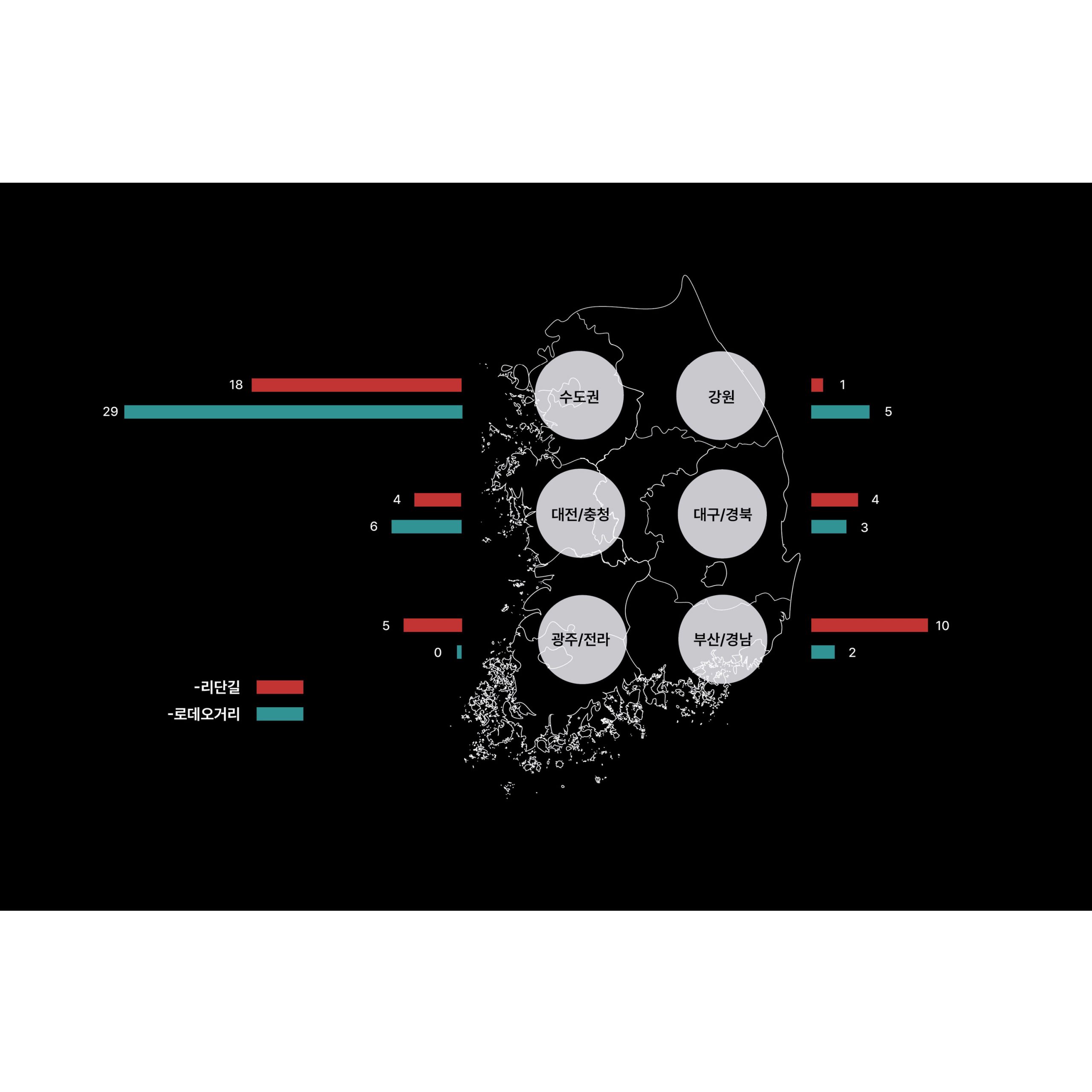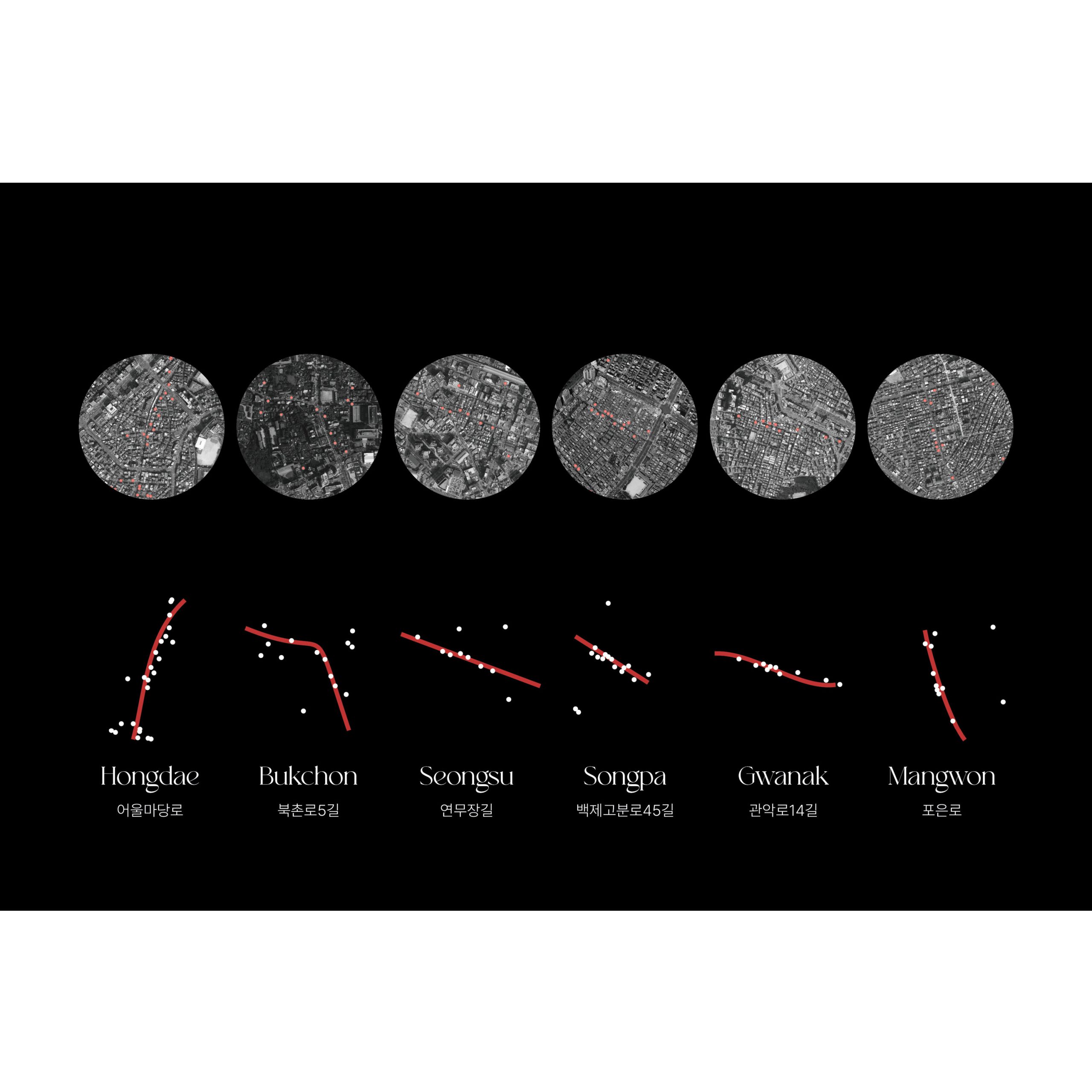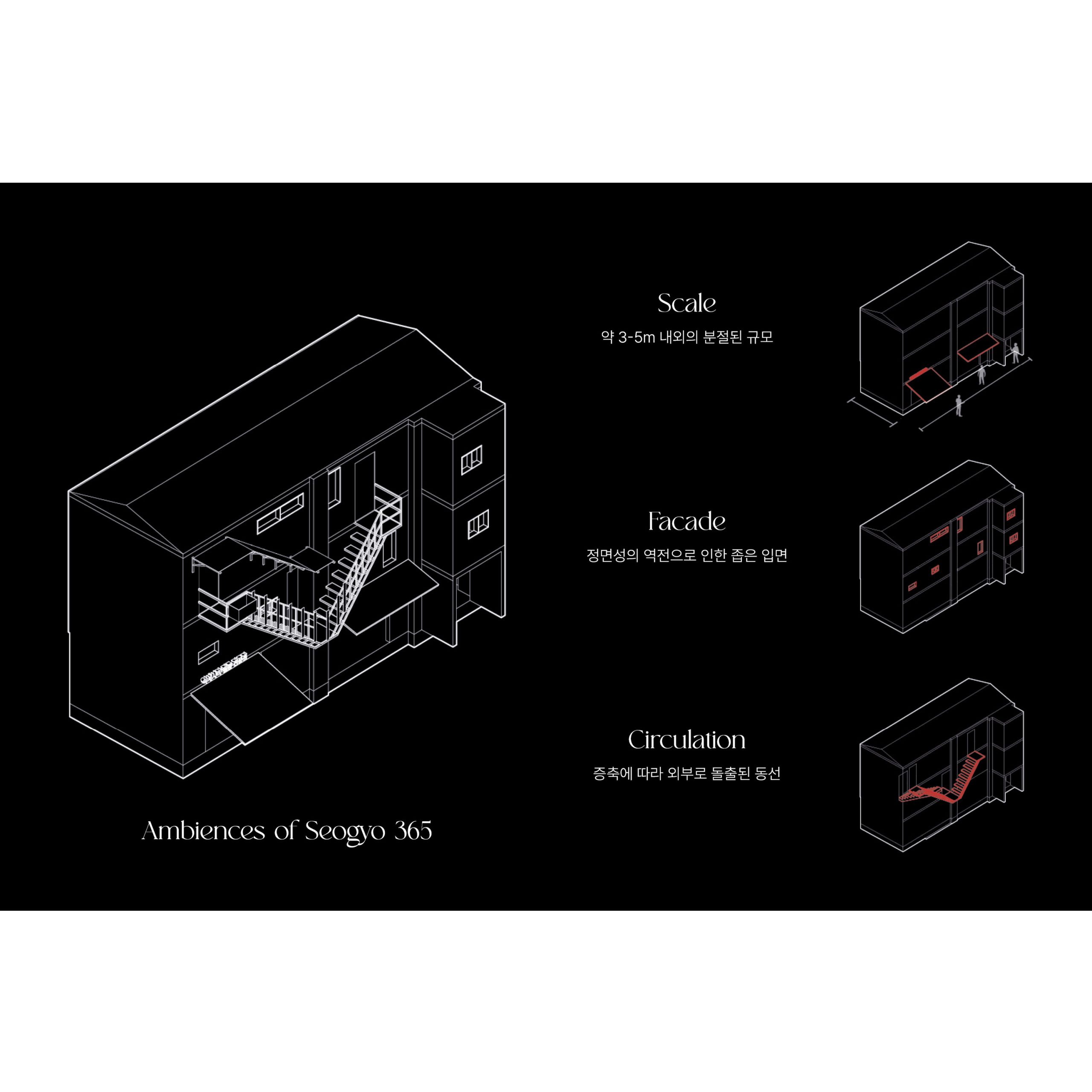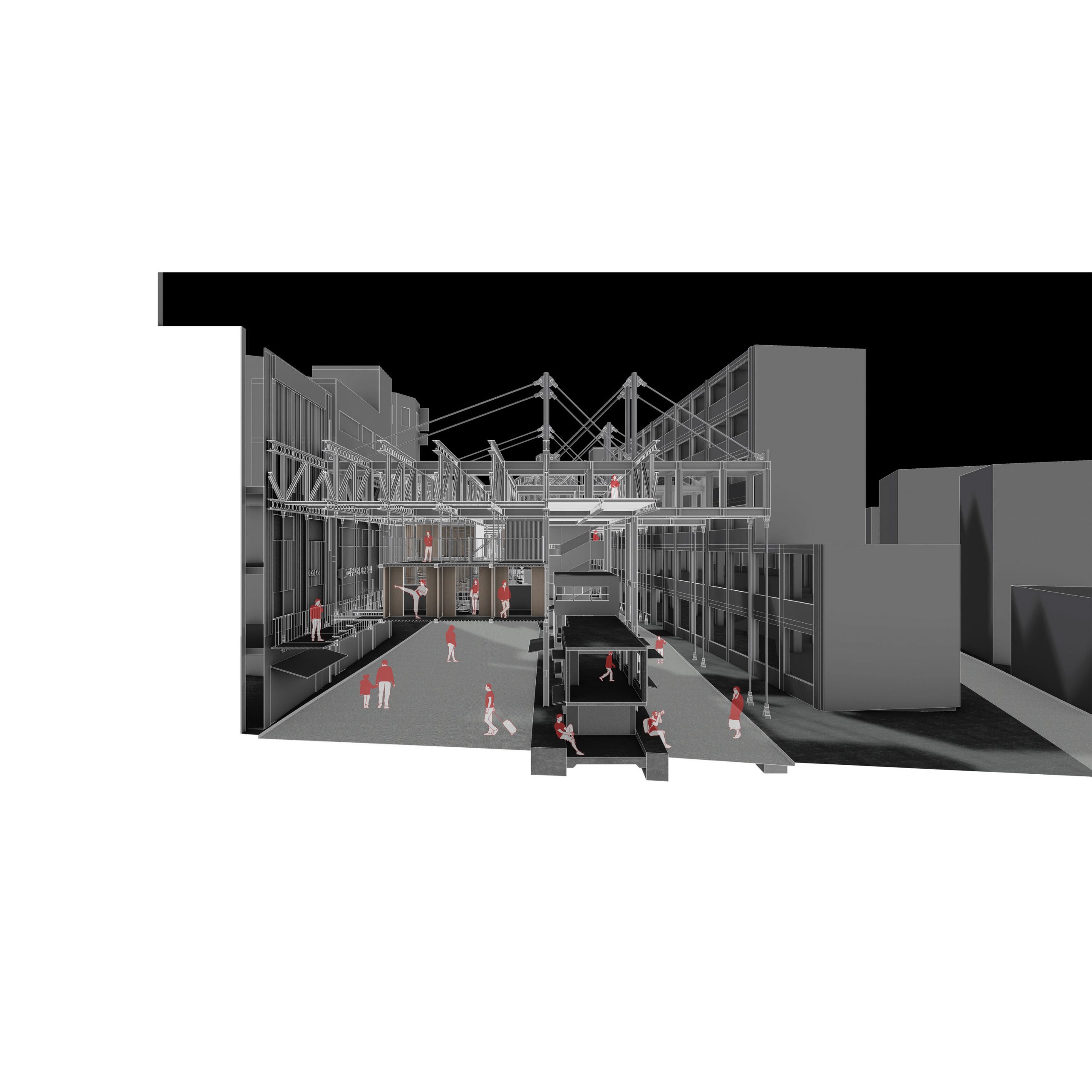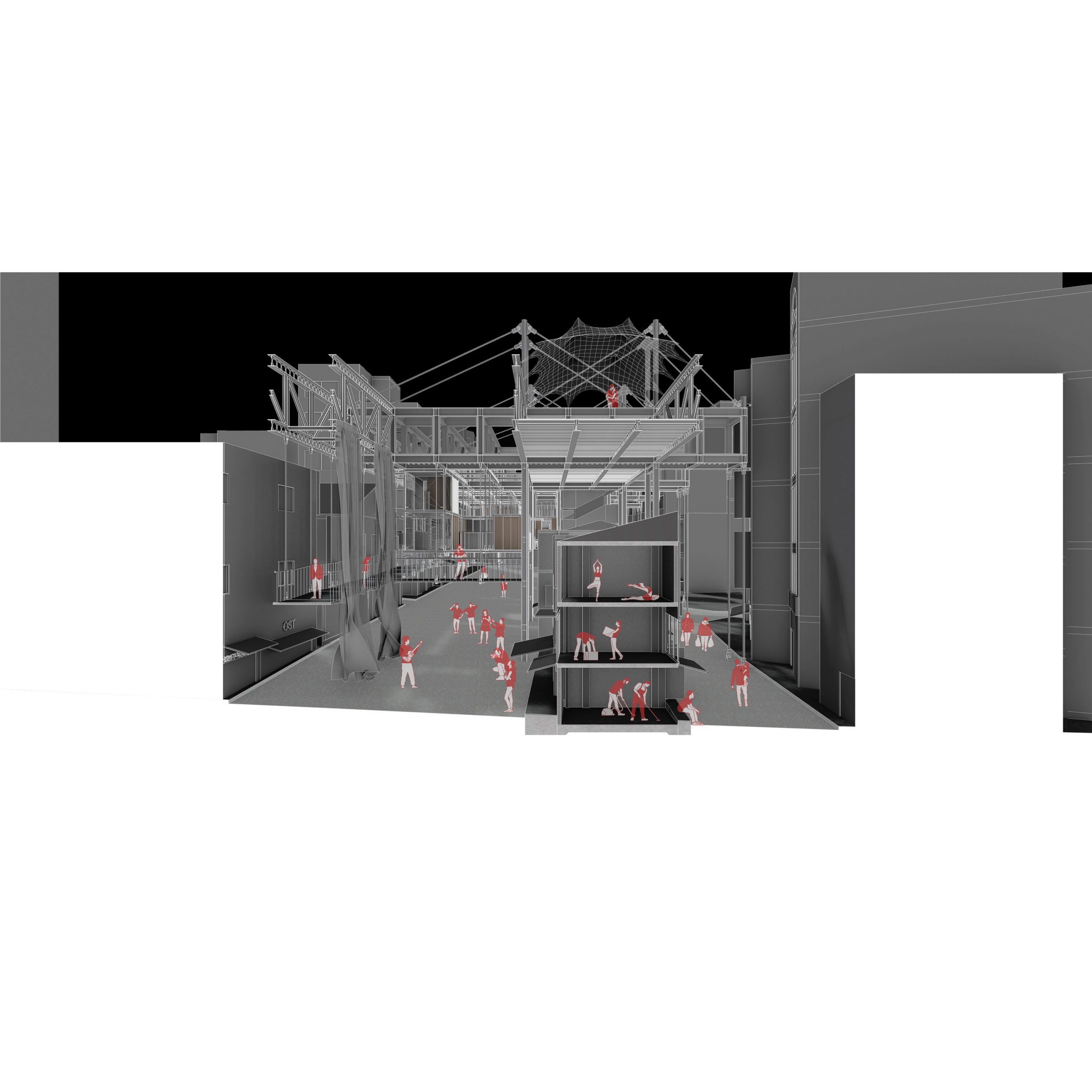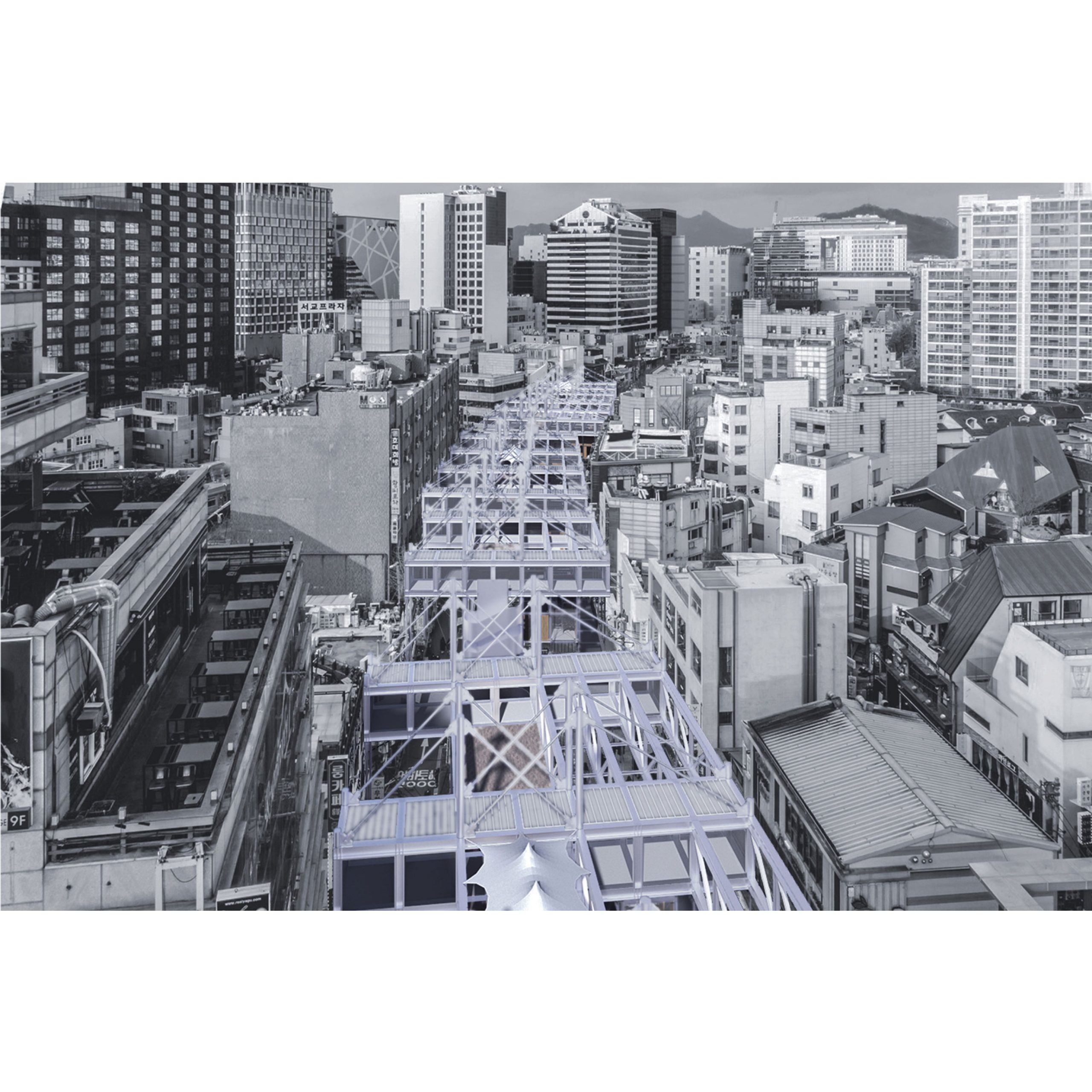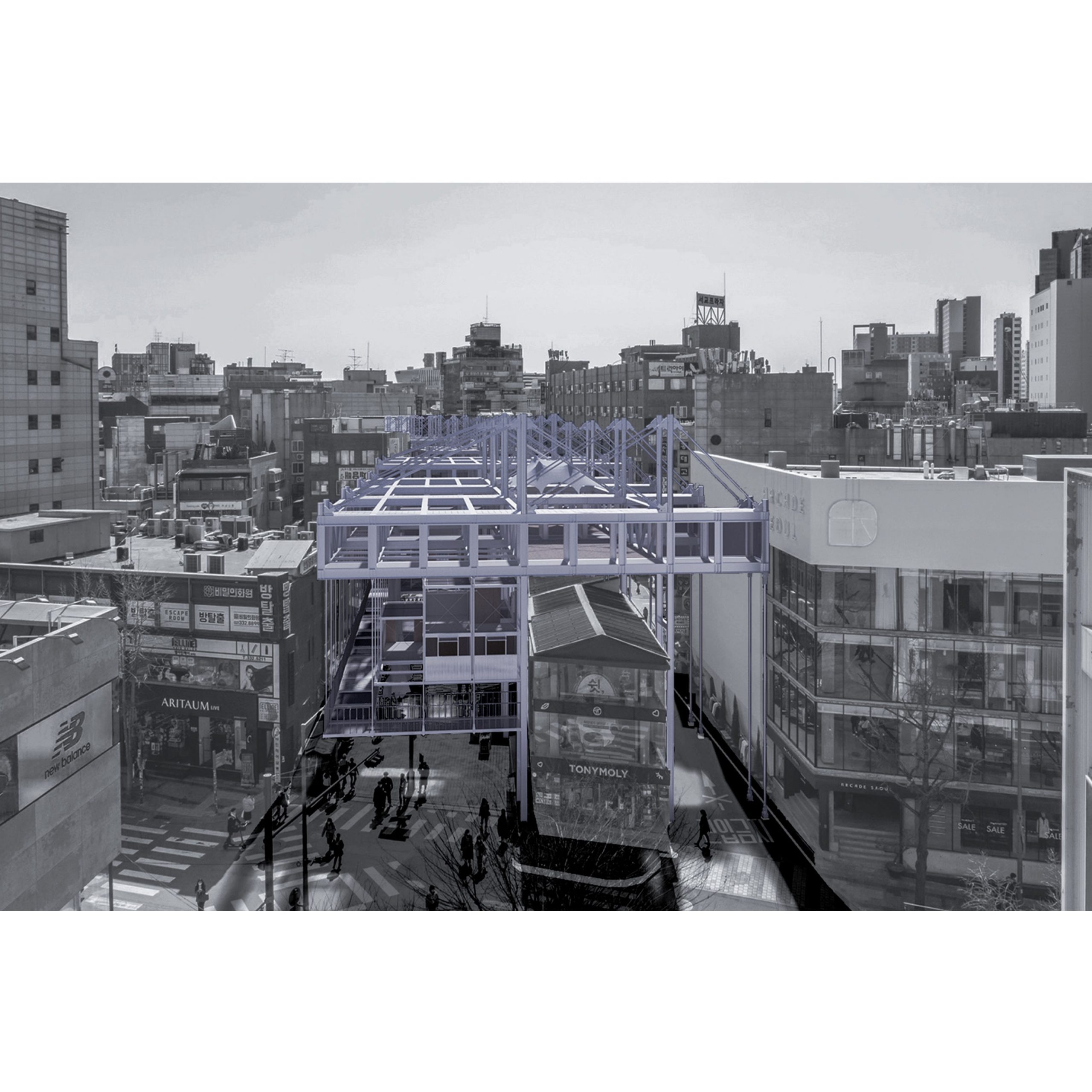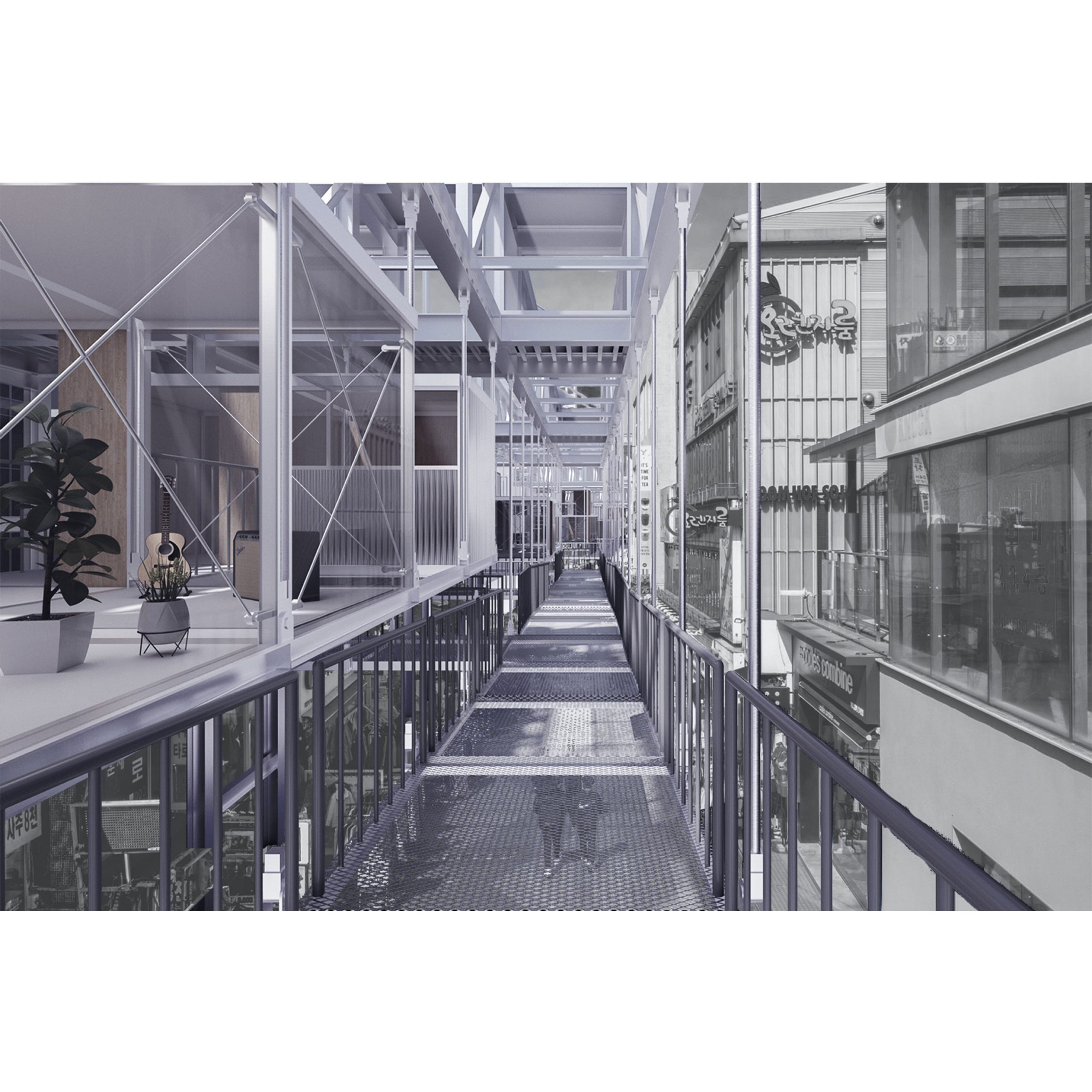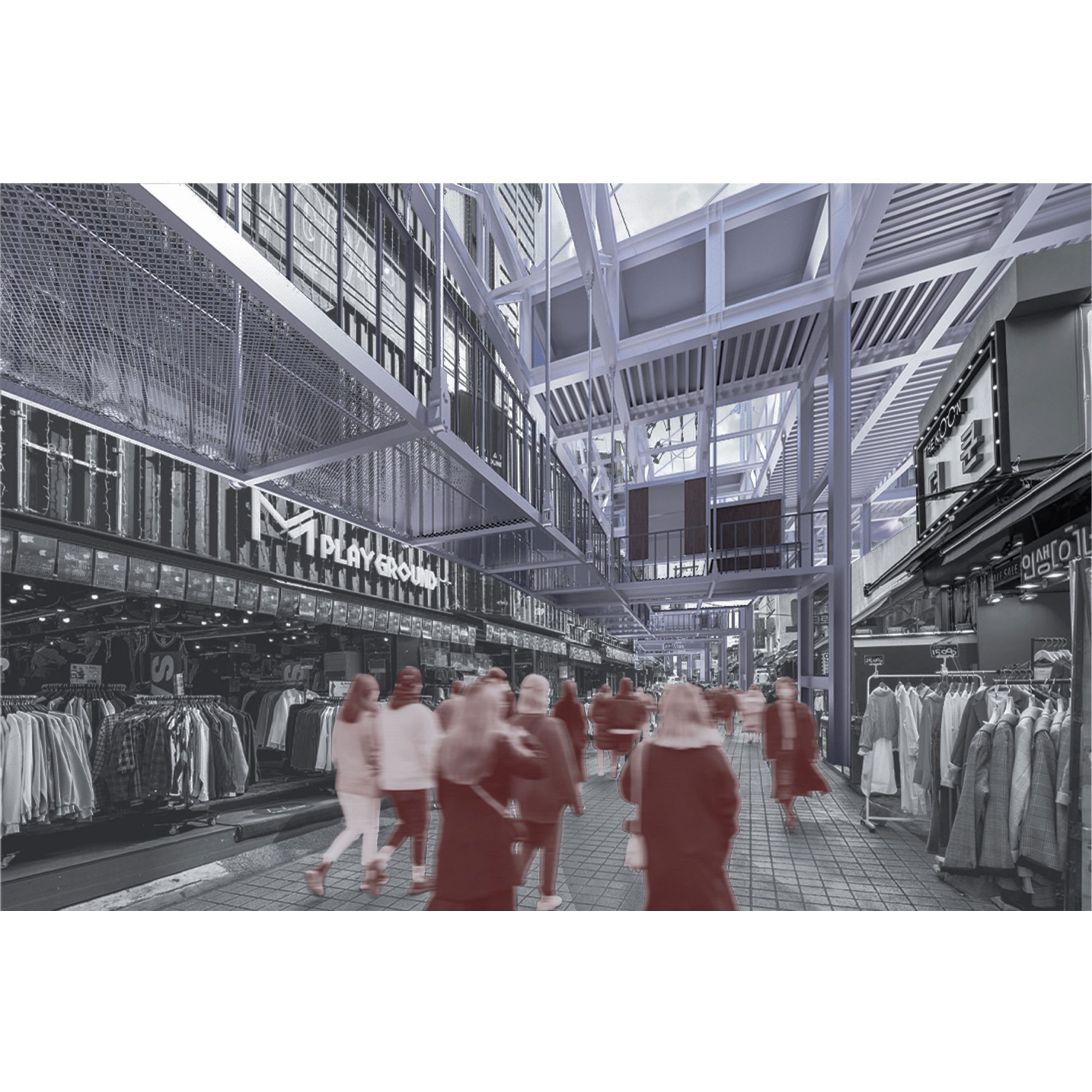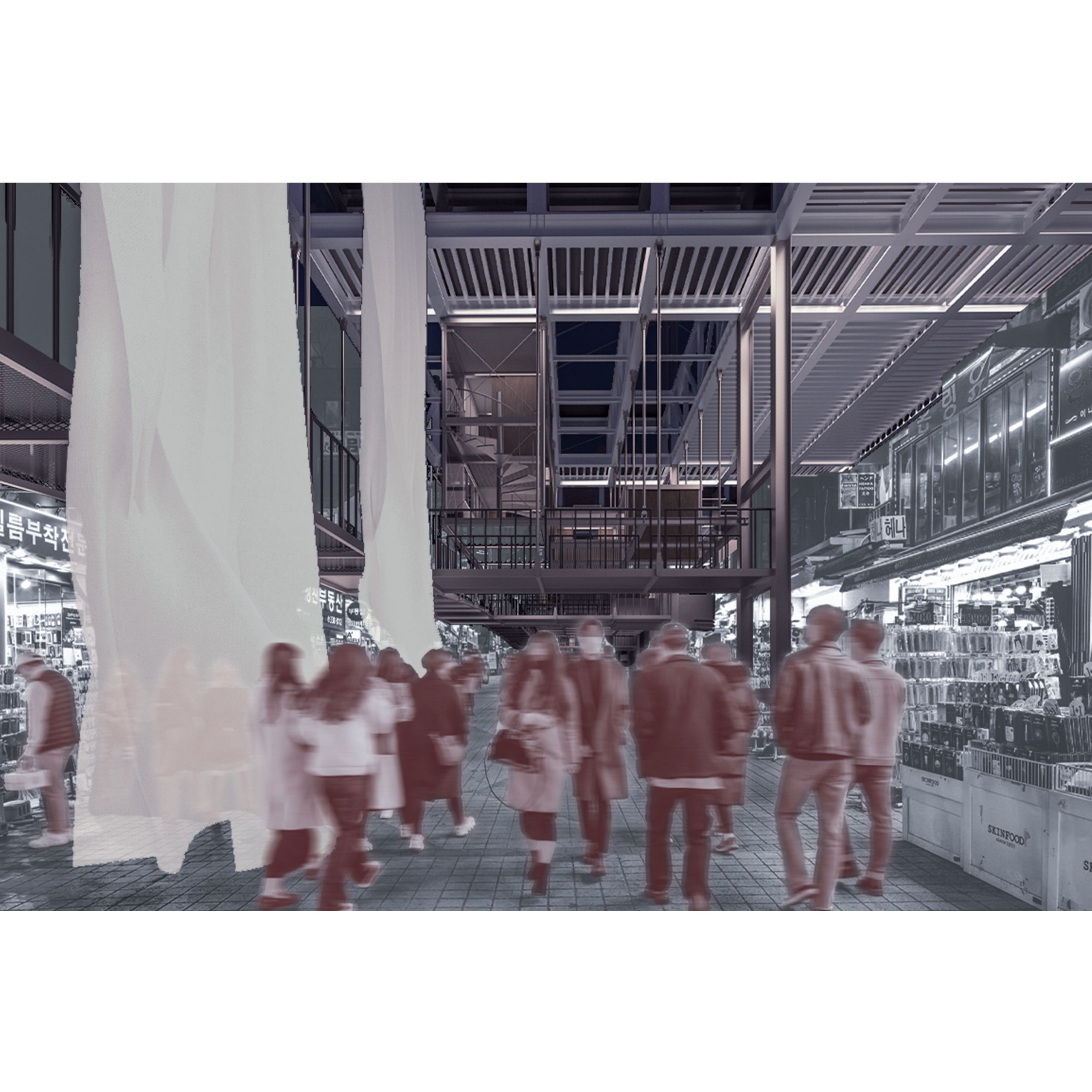남정우
Jungwoo Nam
“Just as the capitalist system continuously produces and reproduces itself economically on higher and higher levels, the structure of reification progressively sinks more deeply, more fatefully and more definitely into the consciousness of man.”
- György Lukács, History and Class Consciousness
우리가 공간을 점유하는 방식은 자본으로부터 자유롭지 않습니다. 자본주의의 구조가 견고해질수록 평범한 삶의 조각들은 점차 깊숙한 단계까지 상품으로 재편되어 세상에 거래됩니다. 이러한 사물화가 가장 명백히 드러나는 곳이 있으니, 바로 상업공간입니다. 도시 속 최초의 상업공간은 시장으로, 다른 지역의 재화를 운반하여 길거리에 자리 잡고 거래하는 곳이었습니다. 시간이 지나 자본주의가 발전함에 따라 이러한 상업공간 역시 변화해왔으며, 근대의 산업화가 가져온 생산력의 증대는 길거리 시장에서 철과 유리로 뒤덮인 ‘아케이드’로, 현대의 에스컬레이터와 공기조화장치는 실내화된 대규모 상업공간인 ‘몰’로의 도약을 이뤄냈습니다. 그리고 지금, 정보화 시대의 새로운 상업공간으로 떠오르는 ‘핫플레이스’ 현상에 주목해보고자 합니다.
전통적인 상업지역은 대로변이나 교통의 요충지 등 소위 ‘목 좋은 땅’이 절대적인 기준이었으나, 인스타그램을 필두로 한 SNS의 발달은 영세한 가게들로 하여금 임대료를 피해 골목 깊숙히 파고드는 것을 가능하게 만들었습니다. 이러한 가게들은 커다란 간판과 투명한 쇼윈도가 아니라 SNS를 타고 전달되는 인스타그래머블한 이미지를 주된 생존 전략으로 삼은 것입니다. ‘-로데오거리’와 ‘-리단길’. 서울 곳곳의 핫플레이스에 자주 붙여지는 이름들입니다. 그 계기가 무엇이든 이들은 모두 ‘길’이라는 선형의 가로를 중심으로 개성 있는 가게들이 자리한 골목들이었고, 이것이 사람들의 기억 속에 자리잡으며 자연스레 핫플레이스를 거리로 정의하는 현상이 나타났습니다. 평범한 골목에도 의미를 부여할 수 있다는 믿음은 그렇게 도시 곳곳으로 퍼지며 거리의 신화를 이뤄냈습니다.
그러나 이 핫플레이스 기제의 끝에는 항상 젠트리피케이션이 기다리고 있습니다. SNS의 도움으로 성장하여 골목의 장소성을 일궈낸 가게들은 역설적으로, 동네의 인기와 함께 높아지는 임대료를 감당하지 못하고 프랜차이즈로 대표되는 대형 자본에 그 열쇠를 넘겨주고 맙니다. 이러한 젠트리피케이션이 진행될수록 장소성이 사라진 핫플레이스 둥지에는 스타벅스, 코인노래방, 셀프사진관과 같은 가게들이 거리를 채워가게 되고, 결과적으로 우리는 어디에서나 볼 수 있는 상업가로의 반복적 경험을 마주할 따름입니다. 그 중 셀프사진관은 일명 MZ - 젊은 세대에 유행하는 상업공간으로, 저렴한 객단가를 높은 유동인구로 만회하는 대표적인 무인업종입니다. 이러한 셀프사진관의 수익 구조는 특성 상 핫플레이스의 젠트리피케이션 정도를 살펴볼 수 있는 척도로 기능할 것이라 판단하였고, 서울의 일부 핫플레이스 - 홍대, 북촌, 성수, 송파, 관악, 망원 - 에 존재하는 셀프사진관 및 이로 인해 정의된 핫플레이스 중심 가로 분석을 진행했습니다.
한편 젠트리피케이션이 고도로 진행된 핫플레이스인 홍대의 중심에, 약 216m 길이의 필지를 가진 건물군이 독특한 모습으로 자리잡고 있었습니다. ‘서교365’라 불리는 이곳은 과거 당인리 발전소로 향하던 당인리선이 지금의 홍대 지역을 가로지르던 시절, 비좁은 기찻길 뚝방 위에 지어진 무허가 판자촌에서 비롯되었습니다. 발전소가 가동을 멈추며 사라진 기찻길은 도로로 바뀌어 도시의 품으로 되돌아갔고, 서교365만이 남아 그 흔적을 간직하게 된 것입니다.
그 과정에서 서교시장을 향한 앞면보다 당인리선을 향한 뒷면이 주된 입면으로 드러나게 되었고, 이러한 정면성의 역전은 서교365의 자생적인 변화를 촉진시키는 계기가 되었습니다. 사용자의 필요에 따라 계단, 진열대, 차양막, 심지어 증축까지 끊임없는 공간의 확장이 이루어지던 서교365는 어느덧 홍대앞 예술 공동체의 터전이 되어 독특한 분위기를 자아냈습니다. 비록 이곳 역시 상업화되면서 과거의 색채를 잃었지만, 서교365의 물리적인 조건들 - 규모, 입면, 동선 - 은 상대적으로 거대 자본의 진입을 늦추는 요소로 작용하여, 지속 가능한 장소성의 단서를 엿볼 수 있었습니다.
저는 이번 프로젝트로 핫플레이스 거리를 따라 시·공간적으로 분절된 새로운 상업공간을 상상해보고, 이를 바탕으로 한 상업의 다양성과 입체화된 가로 경관을 제안합니다. 소유와 임대, 실내와 실외의 이분법적인 공간 점유 방식에서 벗어나, 시스템을 바탕으로 한 공간의 단계적 점유를 통해 젠트리피케이션을 순간의 단절이 아닌 연속의 과정으로 일어나도록 하는 것이 본 프로젝트의 주된 목표입니다. 이를 위해 서교365 및 그 주변, 서교시장길과 주차장길을 포함하는 영역에 주목했습니다. ‘재미의 실험실이자 자유로운 거리의 대학’을 표방한 세드릭 프라이스의 ‘펀 팰리스’와 같이, 불확정적 프로그램들을 수용하는 유동적인 시스템은 핫플레이스로 떠오르기 전, ‘힙플레이스’의 상태로 남을 수 있도록 지원하는 ‘힙 팰리스’로 작동할 것입니다.
먼저 서교365 일대의 도시 구조를 재조직하는 작업을 진행했습니다. 현재 서교365는 약 6m의 폭과 약 216m의 길이를 가진 선형의 건물군입니다. 또한 동쪽으로는 약 12m의 폭을 가진 주차장길이, 서쪽으로는 약 6m의 폭을 가진 서교시장길이 서교365를 기준으로 양분된 상태입니다. 두 길은 약 1.2m의 단차를 가져 주차장길이 서교시장길보다 반층 가량 높고, 가운데 위치한 서교365로 인해 길 사이를 왕래하기 어려운 모습이었습니다. 따라서 입체화된 가로 경관을 도시에 제공하기 위해 서교365의 일부를 철거하여 공공의 영역을 구축하는 전략을 택했고, 이를 효과적으로 드러내도록 주변 도로가 모이는 세 절점을 중심으로 건물군을 비워냈습니다. 철거 후 남겨진 기단을 따라 조성된 새로운 오픈스페이스는 주변 건물로 둘러싸인 비선형적 경관을 형성하는 작은 광장이 되어 줄 것입니다.
다음으로 공공의 영역인 도로 위에 지어지면서도 원활한 보행 환경을 유지하기 위해 대지에 닿는 부분을 최소화하는 것을 목표로 삼았습니다. 그 결과 서교365를 감싸는 기둥 위로 2.4m의 그리드를 가진 비렌딜 트러스를 주요 구조체로 사용하고, 이를 지지하는 텐션 케이블을 서교시장길과 주변 대지의 경계부에 매립하는 단면 시스템을 도출했습니다. 보행로로 쓰일 주차장길 위로, 떠있는 듯 자리잡은 비렌딜 트러스 아래로는 주변 건물과 공유할 수 있는 공중 보행 램프, 그리고 젠트리피케이션으로 내몰린 사람들이 점유하여 사용할 수 있는 프레임을 설치했습니다. 이들은 앞서 재조직된 서교365를 따라 여러 마디로 나뉘어 배치되고, 더불어 서교365의 절단면에 형성된 오픈스페이스와 인프라스트럭쳐의 경계부에는 수직 계단을 배치하여 광장에서 보행 램프로 진입할 수 있는 토대를 마련했습니다.
주어진 시스템을 바탕으로 확장된 서교365에는 공간의 단계적 점유를 위해 사용자가 직접 설치할 수 있는 요소들의 카탈로그를 계획했습니다. 보행 램프로부터 약 1.2m 높게 위치한 프레임은 2.4m의 그리드를 바탕으로 점유의 기본 틀이 되어줍니다. 임대료의 상승으로 내몰린 젠트리파이어들은 다른 지역으로 벗어나기 전, 다양한 방식으로 핫플레이스 거리를 점유하기 위해 바닥과 지붕이라는 수평적 요소, 벽과 창문이라는 수직적 요소, 그리고 계단이라는 사선적 요소를 활용합니다. 공간적으로 건물의 한 층을 분절한 2.4m 정육면체 모듈 기반의 임대 영역을 제공받으며, 이들을 수평적 혹은 수직적으로 조합하여 입체화된 상업공간을 만들어냅니다.
마지막으로 힙 팰리스로 재탄생한 서교365의 운영 방식에 대해 고민했습니다. 홍대 지역 일대에 자리한 수많은 상업 프로그램들은 저마다의 시공간적 특성을 가지고 있습니다. 그러나 핫플레이스 일대의 도시 구조는 이러한 다양성을 수용하기에 한계가 있습니다. 만약 기존의 연 단위 임대 방식에서 벗어나 월, 주, 일 단위의 분절된 임대 방식을 적용해본다면, 앞서 언급한 카탈로그의 요소들을 토대로 공간을 단기적으로 점유하고 해체하여, 서교365 일대의 고유한 장소성을 건물 한 층의 공간을 넘어 거리 곳곳에 퍼트릴 수 있을 것입니다. 그 결과 젠트리파이어, 또 그들에 의해 형성된 ‘힙’한 분위기는 힙플레이스 거리에 남아 젠트리피케이션의 유보에 동참할 것입니다.
The way we occupy space is not free from capital. As the structure of capitalism becomes more solid, the pieces of ordinary life are gradually reorganized into goods and traded into the world to a deeper level. There’s a place where this objectification is most evident, and that’s the commercial space. The first commercial space in the city was the market, where goods from different regions were transported and traded on the streets. As capitalism developed over time, this commercial space also changed, and the productivity of modern industrialization increased from the street market to the ‘arcade’ covered with iron and glass, and modern escalators and air conditioners made a leap into the ‘mall’ which is a large indoor commercial space. And now, I would like to pay attention to the phenomenon of ‘hot place’ emerging as a new commercial space in the information age.
Traditional commercial areas were based on so-called “good-natured land” such as boulevards and transportation hubs, but the development of SNS, led by Instagram, made it possible for small stores to dig deep into alleys to avoid rent. These stores are not big signboards and transparent show windows, but rather instagramable images delivered on social media as their main survival strategy. “-Rodeo Street” and “-Ridan-gil.” These are the names that are often given to hot places around Seoul. Whatever the reason, these were all alleys with unique shops centered on a linear street called “road,” and this settled in people’s memories and naturally defined hot places as streets. The belief that ordinary alleys can also be meaningful has spread throughout the city, achieving the myth of the city.
But there is always gentrification at the end of this hot place mechanism. The stores that grew up with the help of SNS and created the place in the alley paradoxically cannot afford the rising rent with the popularity of the neighborhood and hand over the key to the large capital represented by the franchise. As this gentrification progresses, stores such as Starbucks, coin karaoke, and self-photo studios fill the streets in hot place nests where the place has disappeared, and as a result, we face repeated experiences of commercial streets everywhere. Among them, the self-photo studio is a commercial space popular among the so-called MZ-young generation, and is a representative unmanned industry that makes up for the low cost of customers with a high floating population. The profit structure of this self-photo studio was judged to serve as a measure of the gentrification of hot places due to its nature, and a self-photo studio in some hot places in Seoul - Hongdae, Bukchon, Seongsu, Songpa, Gwanak, Mangwon - and a defined hot place-centered horizontal analysis was conducted.
Meanwhile, in the center of Hongdae, a hot place with highly gentrification, a group of buildings with a length of about 216m was located in a unique shape. Called “Seogyo 365,” it originated from an unlicensed shantytown built on a cramped railroad when the Danginri Line, which used to be heading for the Danginri power plant, crossed the current Hongdae area. The railroad that disappeared when the power plant stopped operating was turned into a road and returned to the arms of the city, and only 3.65 million Seogyo remained to keep its traces.
In the process, the back facing Danginri Line was revealed as the main face rather than the front facing Seogyo Market, and this reversal of frontality served as an opportunity to promote the self-sustaining change of Seogyo 3655. Seogyo 365 has already become the home of an art community in front of Hongdae, creating a unique atmosphere, as the space was constantly expanded to meet the needs of users. Although this place also lost its past color as it became commercialized, the physical conditions of Seogyo 365 - scale, elevation, and movement - acted as factors that slowed the entry of relatively large capital, giving us a clue to sustainability.
With this project, I imagine a new commercial space divided into time and space along the hot place street, and propose commercial diversity and three-dimensional street scenery based on this. The main goal of this project is to break away from ownership and lease, indoor and outdoor dichotomous space occupation, and to allow gentrification to occur in a continuous process rather than a momentary disconnection of space based on the system. To this end, we focused on the area including Seogyo 365 and its surroundings, Seogyo Market Road and Parking Lot Road. Like Cedric Price’s “Fun Palace,” which advocates a “laboratory of fun and a college of free streets,” a fluid system that accommodates uncertain programs will act as a “hip-place” to help them remain in a “hip-place” state before emerging as a hot place.
First, we reorganized the urban structure of Seogyo 365 area. Currently, Seogyo 365 is a linear group of buildings with a width of about 6 m and a length of about 216 m. In addition, the parking lot length, which is about 12m wide to the east, and the Seogyo Market Road, which is about 6m wide to the west, are divided based on Seogyo 365. The two roads had a difference of about 1.2m, so the parking lot was about half a story higher than Seogyo Market Road, and it was difficult to travel between the roads due to Seogyo 365 located in the middle. Therefore, in order to provide a three-dimensional street view to the city, part of Seogyo 365 was demolished to build a public area, and the building group was emptied around the three sections where the surrounding roads gathered to effectively reveal it. The new open space along the stylobate left behind after demolition will be a small square that forms a nonlinear landscape surrounded by surrounding buildings.
Next, the goal was to minimize contact with the ground to maintain a smooth walking environment while being built on roads, which are public areas. The result is a cross-sectional system that uses a vierendeel truss with a grid of 2.4 meters above the pillar surrounding Seogyo 365 and embeds the tension cable supporting it at the boundary between Seogyo Market Road and the surrounding land. Over the parking lot that will be used as a walkway, under the floating vierendeel truss, we have installed a public walking lamp that can be shared with the surrounding buildings, and a frame that can be occupied and used by people driven by gentrification. They were arranged in several sections along the previously reorganized Seogyo 365 and placed vertical stairs at the boundary between the open space and the infrastructure formed on the cutting surface of Seogyo 365 to lay the foundation for entering the walking lamp from the square.
Based on a given system, Seogyo 365 has planned a catalog of elements that users can install themselves for phased occupancy of space. The frame, located approximately 1.2m above the walking lamp, is based on a 2.4m grid and serves as the basis for occupancy. Gentrifiers driven by rising rents use the horizontal elements of floors and roofs, vertical elements of walls and windows, and diagonal elements of stairs to occupy hot place streets in various ways before moving out to other areas. It is provided with a 2.4-meter cube module-based rental area that splits one floor of the building spatially, and combines them horizontally or vertically to create a three-dimensional commercial space.
Finally, I thought about how Seogyo 365 was operated, which was reborn as a hip palace. Many commercial programs located in the Hongdae area have their own spatiotemporal characteristics. However, the urban structure of the hot place area is limited to accommodating this diversity. If we move away from the existing annual rental method and apply a monthly, weekly, and daily split rental method, we can occupy and dismantle space in the short term based on the aforementioned elements of the catalog, spreading the unique location of Seogyo 365 across the street. As a result, the gentrifier, and the ‘hip’ atmosphere formed by them, will remain on the hip place streets and join the reservation of gentrification.


